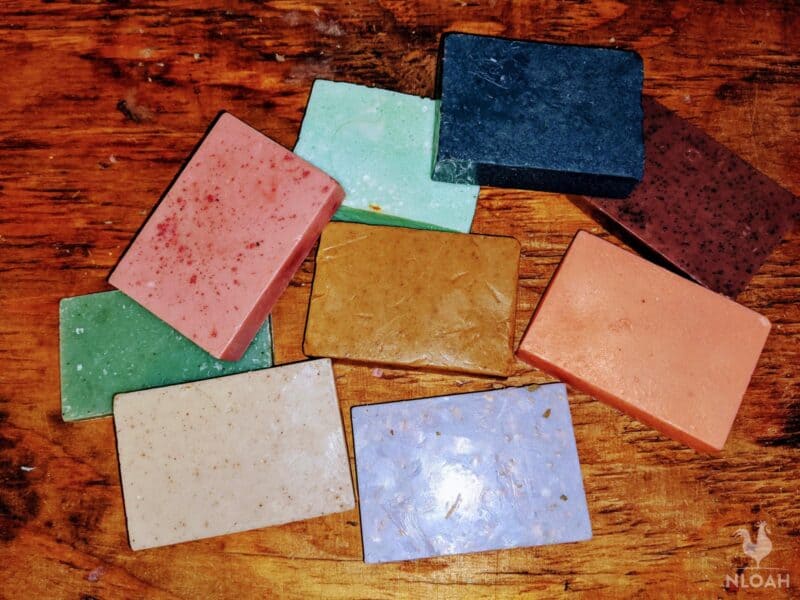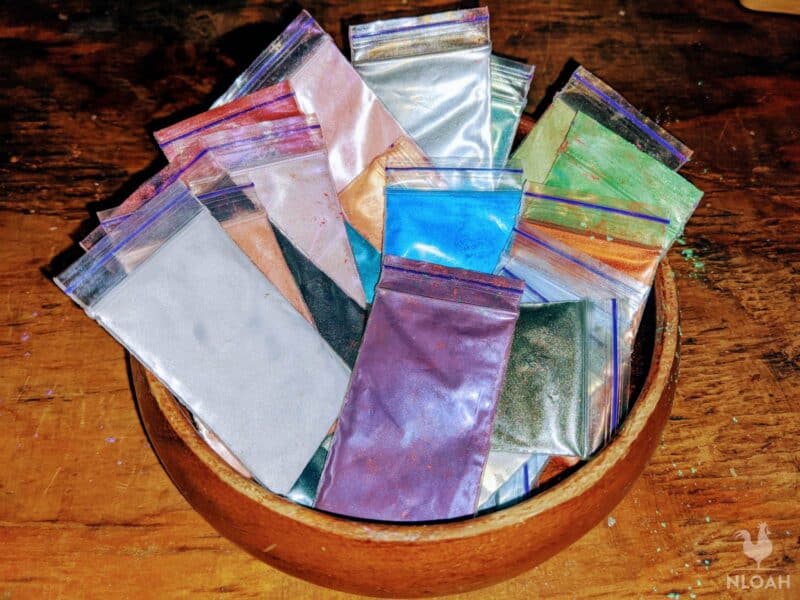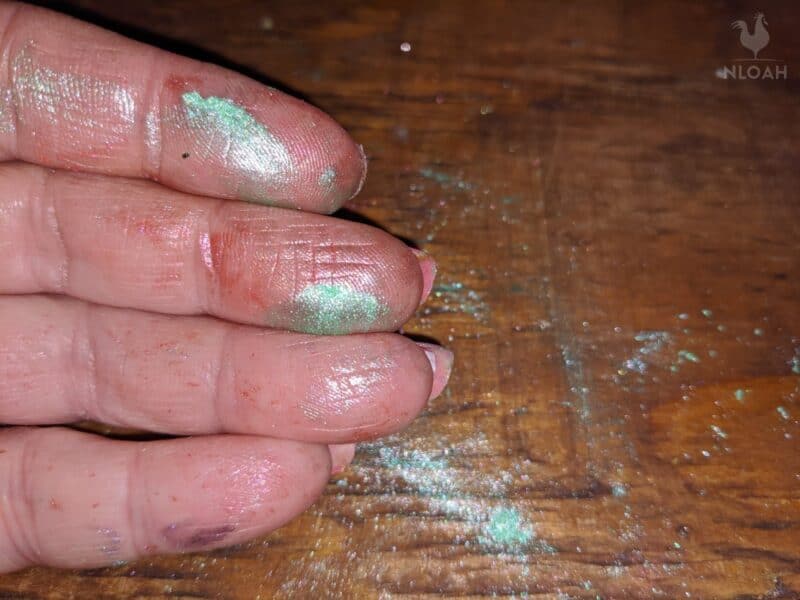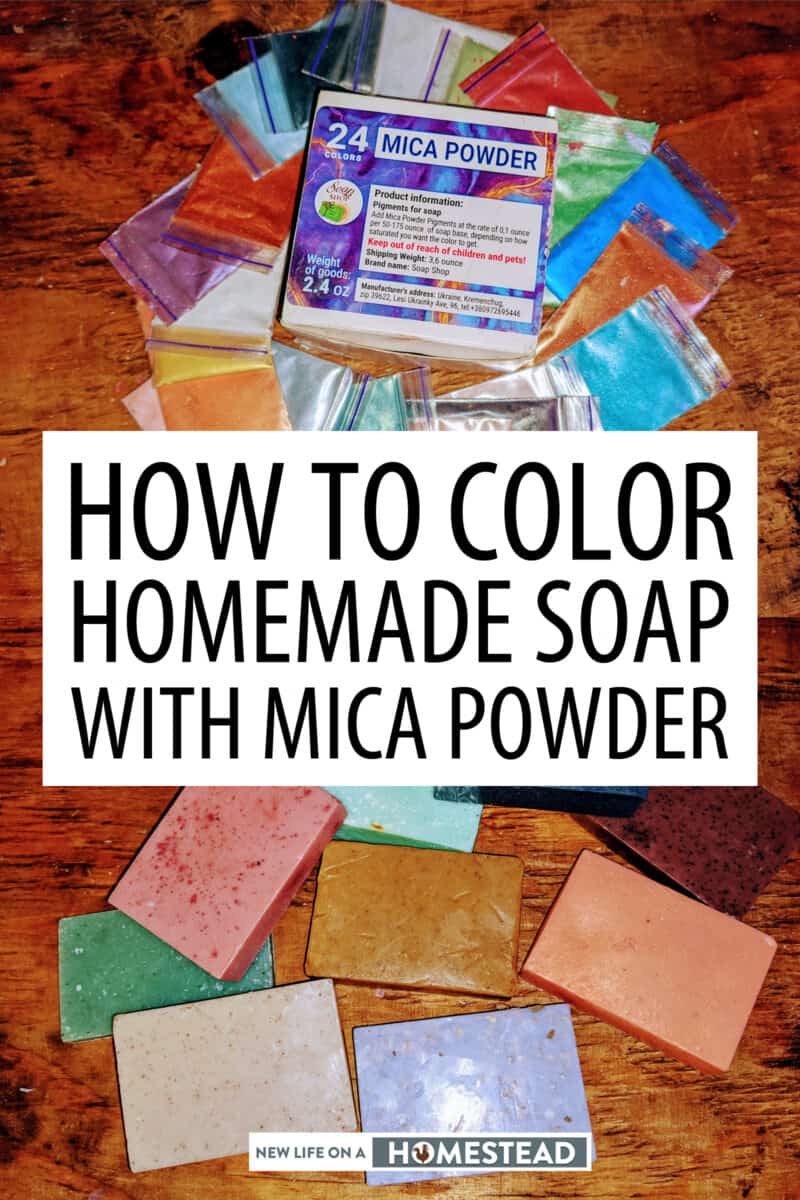Coloring homemade soap with mica powder is a quick and simple way to create a vibrant colored soap naturally. Using mica powder to make bold or pastel hues in homemade soap also allows the maker to match the color of the bar to the scented ingredients, season, or holiday celebration.

You can use mica powders to color melt and pour soap bases, cold process (CP) soap bases, and even hot process (HP) or “crockpot” style soap bases.
What Is Mica Powder?
Mica powders are a colorant that infuses a shimmery pigment to soap – and a plethora of other projects. The powder comes from a stone mineral that naturally boasts fine and shimmery flakes.
Once the stone is ground to make a powder, it can be used to add shine and a glittery effect to a project, or be colored to create distinctive pigment shades.
When gathered from the muscovite stone, mica is white, yellow, gray, or slightly brown in shade. This type of metamorphic rock also contains potassium aluminum silicate compounds. You can use untinted mica powder to create any of the above shades in a homemade soap.

Mixing Pigments With Melt And Pour Soap
If you want to mix several shades of mica powder to create your own unique shade to add to a homemade bar of soap, all you need is a little bit of carrier oil or 91 percent rubbing alcohol.
- Mix 1 teaspoon of mica powder with 2 teaspoons of your favorite carrier oil or 1 teaspoon of rubbing alcohol. Using rubbing alcohol in the soap colorant mixture may also help prevent air bubbles from forming in the recipe.
- Stir the mica powder and oil or alcohol mixture together and review the shade that has been created.
- If you like the shade, continue on with the coloring steps, if not, mix in a little more mica powder to alter the shade.
- If the mixture is too thick when more mica powder is stirred into the mix, add a single drop more of carrier oil or rubbing alcohol to thin it out.
Coloring Melt And Pour Soap Bases With Mica Powder
- Use 1 teaspoon of mica powder for every pound of soap being melted to create the homemade bars.
- Heat the melt and pour soap base until it liquifies as per your recipe instructions.
- Stir in the teaspoon of mica powder immediately upon removing the melted soap base from the microwave or double boiler.
- Continue to follow the melt and pour soap base recipe you are using to finish creating and curing the bars.
Coloring Cold Process Soap With Mica Powder
- Follow your cold process soap recipe and do not add in the mica powder mixture until you have a fully liquid base to work with.
- Combine 1 tablespoon of 99 percent rubbing alcohol with 1 teaspoon of mica powder. Water, especially distilled water, can also be used, but rubbing alcohol works a lot better to create a vibrant color – and can reduce air bubbles.
- Stir to combine the mica powder and cold process soap base thoroughly and inspect the shade you created.
- If you want a darker or more vibrant color, simply stir in more mica powder at 1/4 of a teaspoon increments. More rubbing alcohol or water does not need to be added unless your mixture becomes too incredibly thick. Add in the extra liquid sparingly and always stir to combine thoroughly and inspect the color and texture before adding more.

How To Add Mica Powder To Hot Process Soap
Coloring hot process soap is a bit more challenging than adding pigment to either melt and pour soap bases or cold process soap recipes. There are two ways to add color to hot process soap recipes, duirng the pre-cook staghe or after the recipe has been cooked and has a far thicker consistency – one that loosely resembles mashed potatoes.
In my personal experience, adding in color before cooking the hot process soap recipe works far better to get a more uniform and vibrant shade.
Mica powder works well in hot process soap, in my personal experience, especially in the post-cook state to avoid a poor interaction with the lye. Some colorant types are not heat stable and will fade over time, especially ultramarine pigments.
- Follow your hot process soap recipe by melting the butters and oils together.
- Once the lye solution has been created and blended in, wait roughly 15 minutes until the soap batter has firmed up and reached the “mashed potato” stage.
- First, melt your oils and butters in a crock pot. Then, create your lye solution and add it to your crock pot. Use a stick blend to mix to trace and cover the crock pot. After about 15 minutes, stir the batter and replace the lip. Continue to stir every 15 minutes until the soap batter has the consistency of mashed potatoes. Then, place the soap in a mold and allow it to set up for 24 hours. After, remove from mold, cut, and allow it to cure for about 1-2 weeks. Although the bar may technically be safe to use, allowing it to cure will provide a harder, better quality bar of soap.
- Stir the dry mica powder into the soap batter until it has combined thoroughly at a rate of 1 teaspoon per pound of soap. I do not mix in a carrier oil or rubbing alcohol when coloring hot process soap, but some folks do. If you choose to try this coloring smoothing and spreading optional step, refer to the cold process water or rubbing alcohol and mica powder mixing ratio.
- Follow your hot process recipe curing steps to complete the bar of soap.
Painting Soap With Mica Powder
If you are using a soap mold that is textured or boasts an intricate design, it can be painted with mica powder AFTER it has cured.
Sometimes mica powder (and other colorant types) will “bleed” a bit when mixed into any type of soap bases – but especially with a hot process recipe. Some soap makers intentionally bleed a color to make a swirl design.
When first learning how to color homemade soap with mica powder, I highly recommend making only a small batch consisting of a few bars.
While the coloring process is very straightforward, there is some trial and error involved. It is far better to waste only a small amount of the mica powder and soap ingredients than a lot more time and sometimes pricey ingredients.


Tara lives on a 56 acres farm in the Appalachian Mountains, where she faces homesteading and farming challenges every single day, raising chickens, goats, horses, and tons of vegetables. She’s an expert in all sorts of homesteading skills such as hide tanning, doll making, tree tapping, and many more.
